You are using an out of date browser. It may not display this or other websites correctly.
You should upgrade or use an alternative browser.
You should upgrade or use an alternative browser.
Birks Asscher Alexandrite?
- Thread starter DecoHouse
- Start date
- Joined
- Jun 29, 2008
- Messages
- 10,261
No idea who Birks are (sorry) but thought you might be interested to read a bit more:
[URL='https://www.pricescope.com/community/threads/have-you-really-got-an-alexandrite-read-this-first.179784/']https://www.pricescope.com/community/threads/have-you-really-got-an-alexandrite-read-this-first.179784/[/URL]
Your photos highly suggest this is not an alexandrite and could well be synthetic corundum or a colour change sapphire or spinel or or or or or - having said that, alexandrites are the worst stones in the world to photograph! Despite what anybody will tell you, this is one gemstone that needs to go to a lab to determine whether it's an Alex or not because the synthetics display all the same characteristics (ie RI) as their real counterparts. There are tell take signs however such as inclusions but that's not discernable from your photos - other than that the cut for an Alex is highly unusual and also the lack of inclusions.
Also, don't forget, stones can be switched in settings so for example you might buy a Tiffany ring that's got all the right hallmarks etc and IS a Tiffany but somebody switched out the diamond and put in a different stone.
[URL='https://www.pricescope.com/community/threads/have-you-really-got-an-alexandrite-read-this-first.179784/']https://www.pricescope.com/community/threads/have-you-really-got-an-alexandrite-read-this-first.179784/[/URL]
Your photos highly suggest this is not an alexandrite and could well be synthetic corundum or a colour change sapphire or spinel or or or or or - having said that, alexandrites are the worst stones in the world to photograph! Despite what anybody will tell you, this is one gemstone that needs to go to a lab to determine whether it's an Alex or not because the synthetics display all the same characteristics (ie RI) as their real counterparts. There are tell take signs however such as inclusions but that's not discernable from your photos - other than that the cut for an Alex is highly unusual and also the lack of inclusions.
Also, don't forget, stones can be switched in settings so for example you might buy a Tiffany ring that's got all the right hallmarks etc and IS a Tiffany but somebody switched out the diamond and put in a different stone.
- Joined
- Apr 22, 2004
- Messages
- 38,363
Please get the stone checked out:
1. The stone could have been switched out some time down the road.
2. Without knowing the change or shift, it could be a colour change sapphire (natural or synthetic).
The colour does not look like any alexandrite I've seen but then again, you've not described the colour at all so perhaps what I see isn't what you see.
1. The stone could have been switched out some time down the road.
2. Without knowing the change or shift, it could be a colour change sapphire (natural or synthetic).
The colour does not look like any alexandrite I've seen but then again, you've not described the colour at all so perhaps what I see isn't what you see.
It's teal green in daylight, and has this strange mix of teal and purple sitting near a window. It went dark purple last night.
There are a few spots in the stone that turn almost baby pink, and last night when it was dark purple it flashed red. The color is not even at all.
I can't get a picture of the change, I figured flash on/daylight with flash.. something might work. But no.
There are a few spots in the stone that turn almost baby pink, and last night when it was dark purple it flashed red. The color is not even at all.
I can't get a picture of the change, I figured flash on/daylight with flash.. something might work. But no.
- Joined
- Apr 22, 2004
- Messages
- 38,363
- Joined
- Apr 22, 2004
- Messages
- 38,363
Did you get the opportunity to read LD's link yet? There are pictures of various quality alexandrites, including synthetic and simulants. The best way to find out for sure is to have your gemmologist check the refractive index to narrow down the possibilities (simulant or chrysoberyl), then from there, verify if it is natural or synthetic.
- Joined
- Jun 29, 2008
- Messages
- 10,261
Looking at your photos, if they're an accurate representation of what you see (and your description definitely matches the photos) then this isnt an Alex. The colourways are wrong.
Other clues are:
Cutting an Alex into an Asscher type cut? Highly highly unusual. I've never seen this done - that's not to say it's not possible but it points to something other than an Alex.
The size - looking at the photos this is a deep stone so I suspect it is something in the region of 3ct or so? Again, cutting a 3ct Alex into an Asscher? Not likely (but not impossible).
The colour change - for such a large stone the fact that it changes 100% (ignoring the mixed lighting conditions), again, is highly suggestive this isn't an Alex and is actually synthetic corundum. Also the colours are wrong for an Alex. There is no hint of green which is what you would see in daylight. I can't recall if I've put photos in the thread I linked to of what colours you should see but if I have, you'll see how very different your stone looks.
The table facets are abraded badly and I think other chips and dings are shown in the photograph even though they look like inclusions. If that's the case and this stone has virtually no inclusions, it is a concern. Again, this is an indicator that this isn't Alex.
Having said all of the above, I'm basing what I've said on photographs and this is not conclusive. It was very usual years ago to use synthetic corundum in jewellery and this often pops up as "alexandrite". You don't see it as much nowadays and therefore it has a curiosity value all by itself.
Other clues are:
Cutting an Alex into an Asscher type cut? Highly highly unusual. I've never seen this done - that's not to say it's not possible but it points to something other than an Alex.
The size - looking at the photos this is a deep stone so I suspect it is something in the region of 3ct or so? Again, cutting a 3ct Alex into an Asscher? Not likely (but not impossible).
The colour change - for such a large stone the fact that it changes 100% (ignoring the mixed lighting conditions), again, is highly suggestive this isn't an Alex and is actually synthetic corundum. Also the colours are wrong for an Alex. There is no hint of green which is what you would see in daylight. I can't recall if I've put photos in the thread I linked to of what colours you should see but if I have, you'll see how very different your stone looks.
The table facets are abraded badly and I think other chips and dings are shown in the photograph even though they look like inclusions. If that's the case and this stone has virtually no inclusions, it is a concern. Again, this is an indicator that this isn't Alex.
Having said all of the above, I'm basing what I've said on photographs and this is not conclusive. It was very usual years ago to use synthetic corundum in jewellery and this often pops up as "alexandrite". You don't see it as much nowadays and therefore it has a curiosity value all by itself.
Share:
Featured Topics
Past, Present, Future: The Meaning of Three-Stone Engagement Rings Past, Present, Future: The Meaning of Three-Stone Engagement Rings - 04/14
Past, Present, Future: The Meaning of Three-Stone Engagement Rings - 04/14


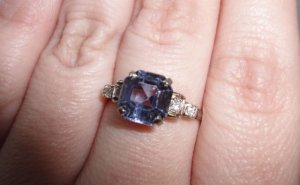


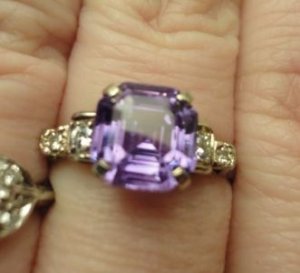
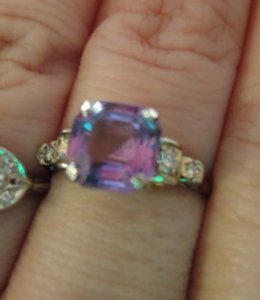
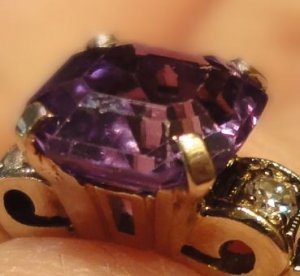
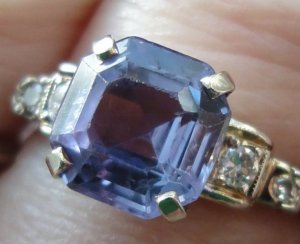

300x240.png)